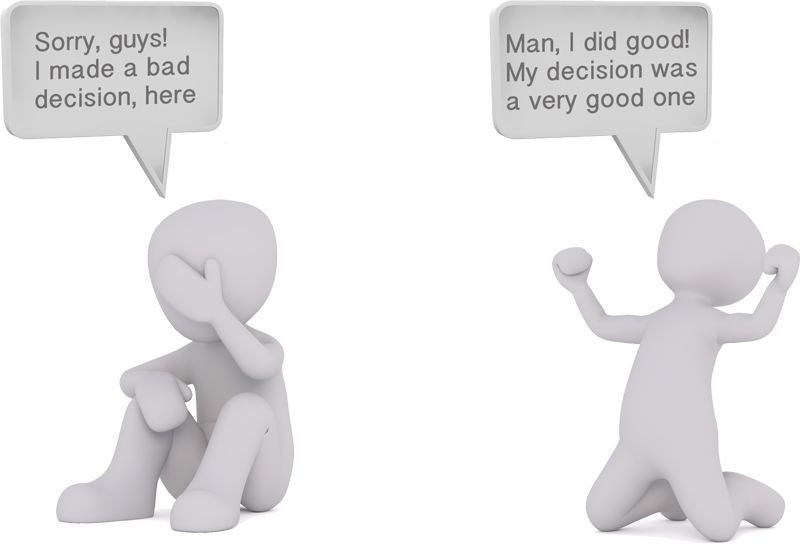A great barrier to progress relates to decision making. Without clarity in decisions, directions and prioritizations become ambiguous. This translates to slower, and in worst case, a randomly moving business.
At Northern.tech we follow a few simple key decision making principles.
Make Frequent, Smaller Decisions
According to our Continuous everything principle, we value frequent smaller changes over infrequent, large ones.
Do not linger, move forward. Forward momentum calls for a decision, one way or the other. In a learning environment with established ways to recover and repair, making wrong decisions frequent is better than infrequent and time-consuming “correct” ones. The reason is simple. We will recover from a wrong decision and correct it faster than the ones who seek “safety” and correctness all the time.
One Person Responsible
At Northern.tech there shall always only one person responsible for a decision. Everyone has roles and responsibilities. Decisions within a role belong solely to that one person.
Decisions made by groups, committees, or some sort of voting must be avoided. Why? Group decisions nurture politics and mediocrity. In group decision environments some undeservedly can become the ones who manage to sneak out the back door following a bad decision, or by contrast the ones basking in all the glory following great decisions. Such behavior gives rise to toxicity. Further, with only one person responsible, the likelihood of this person driving execution and fulfillment of the decision will be higher than if it is a shared decision.
Seek Collective Wisdom
Although there is only one person responsible for a decision, we strongly encourage to seek input and advice from as many people as possible. Definitely, stakeholders affected by a decision should be heard, but there is no downside in involving anyone willing to share their thoughts. The best of insights might come from the most unexpected corner.
When asking for input from others, be grateful for any reply. This shows that people actually care about the decision you are going to make. Consider it a gift that someone decides to spend their brain cycles to share thoughts and insights with you. Don’t expect any feedback and be grateful when you do, regardless of its content.
Feedback unanimously against your proposed decision should call for extra rounds of introspective analysis before making a final decision. However, regardless of the feedback, the decision remains yours, and yours alone.
Take Responsibility
A sound decision takes the input of others into account. You express understanding of various views. People accept a decision more easily when they feel they have been listened to, even if it goes against their recommendation.
When a decision has been made, one must stand behind it, 100%. Be proud of wise decisions. You did good! Bad decisions are caused by your poor judgment. Learn from it, be honest and open about miscalculations. Move on.
Stand straight both in good and bad times. Respect follows.

Negative Veto Exceptions
For decisions that partly belong to or touch upon other roles, veto exceptions come into play. The positive decision still remains with one person, but relevant stakeholders have a negative veto against moving forward.
One example is recruiting. When we recruit new employees, anyone in the recruitment team has a veto against hiring a candidate. It doesn’t matter who, or why. As long as one of the team members puts the thumb down, the candidate is automatically disqualified.
Other examples include bigger, more widespread decisions. For instance a decision might have sizable financial implications and need the sign-off from finance. Another example could be product decisions of such character that it gives the architect role a right to veto.
The nature of a decision decides the empowerment of a negative veto right, or not. Decision makers are left with common sense to make these judgment calls.
Dealing with conflicts
This decision making process might lead to certain conflicts. The three typicalexamples are:
- Two people of same role can’t agree
- Two people of different roles can’t agree
- More than one function is affected (aka decision is “big”)
So, how do we best deal with these?
1. Two people of same role can’t agree
If two people of the same role can’t agree on a decision, the assigned decision-maker of the team shall be the final arbitrator.
2. Two people of different roles can’t agree
If two people of different roles, but within the same team can’t agree on a decision, the leader of the team shall be the final decision maker.
If two people of different roles from different teams can’t agree on a decision, the leader of both teams (currently Thomas) shall be the final decision maker.
3. More than one function is affected (aka decision is “big”)
If a decision impacts more than one function (aka decision is “big”), the decision shall be made by a dedicated decision maker of all impacted functions.
For bigger decisions with long-term effects, a written “Executive Decision Making Summary” shall be created and form the basis of the decision.
Be mindful about your desired outcome
Not being clear whether an action / question / issue requires a decision, or not is a common mistake. This mistake easily leads to long discussions, circilized opinions, and waste of time.
Whenever initiating something, it is paramount to:
- Upfront make it clear whether a decision is to be made or not
- Clarify who the decision maker is
By being clear on these two points early on, we will ensure an effective and efficient decision making culture.
